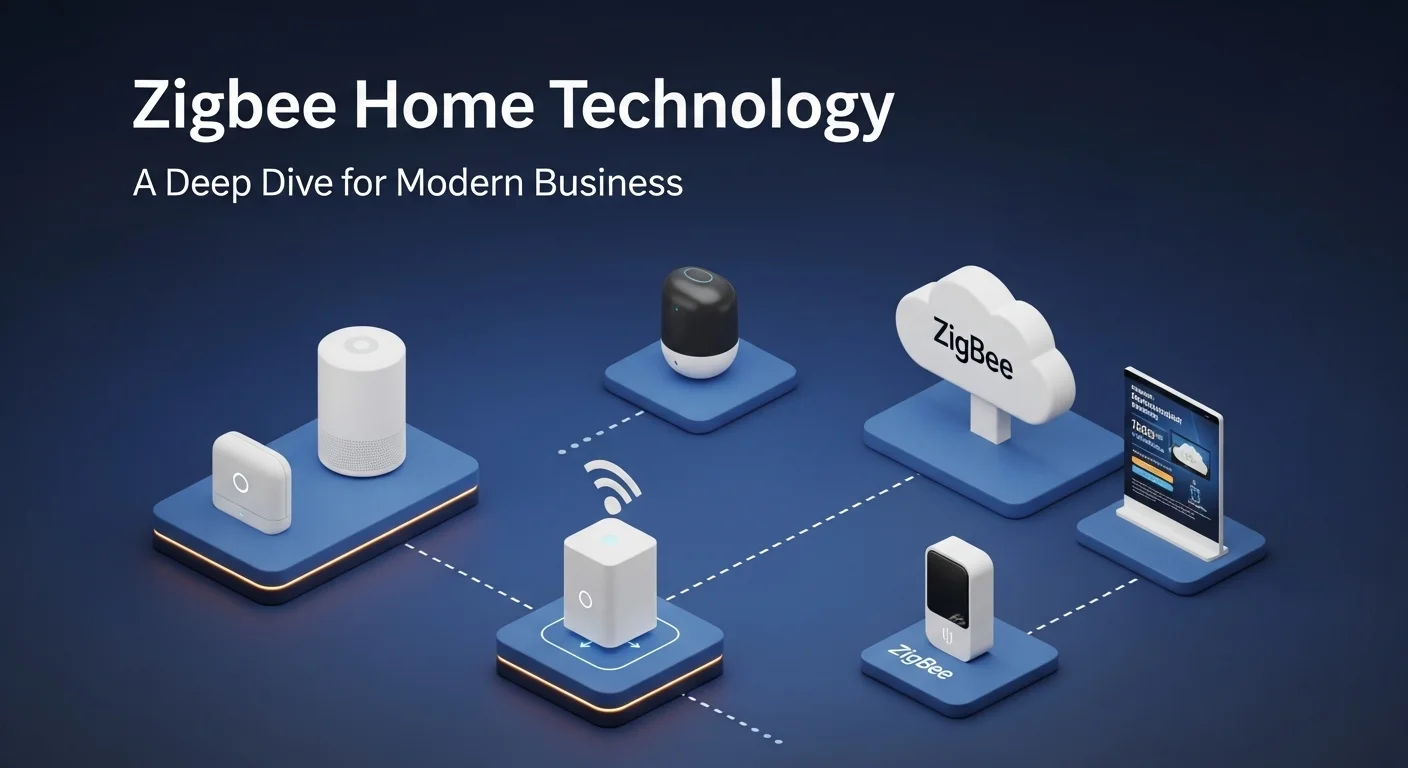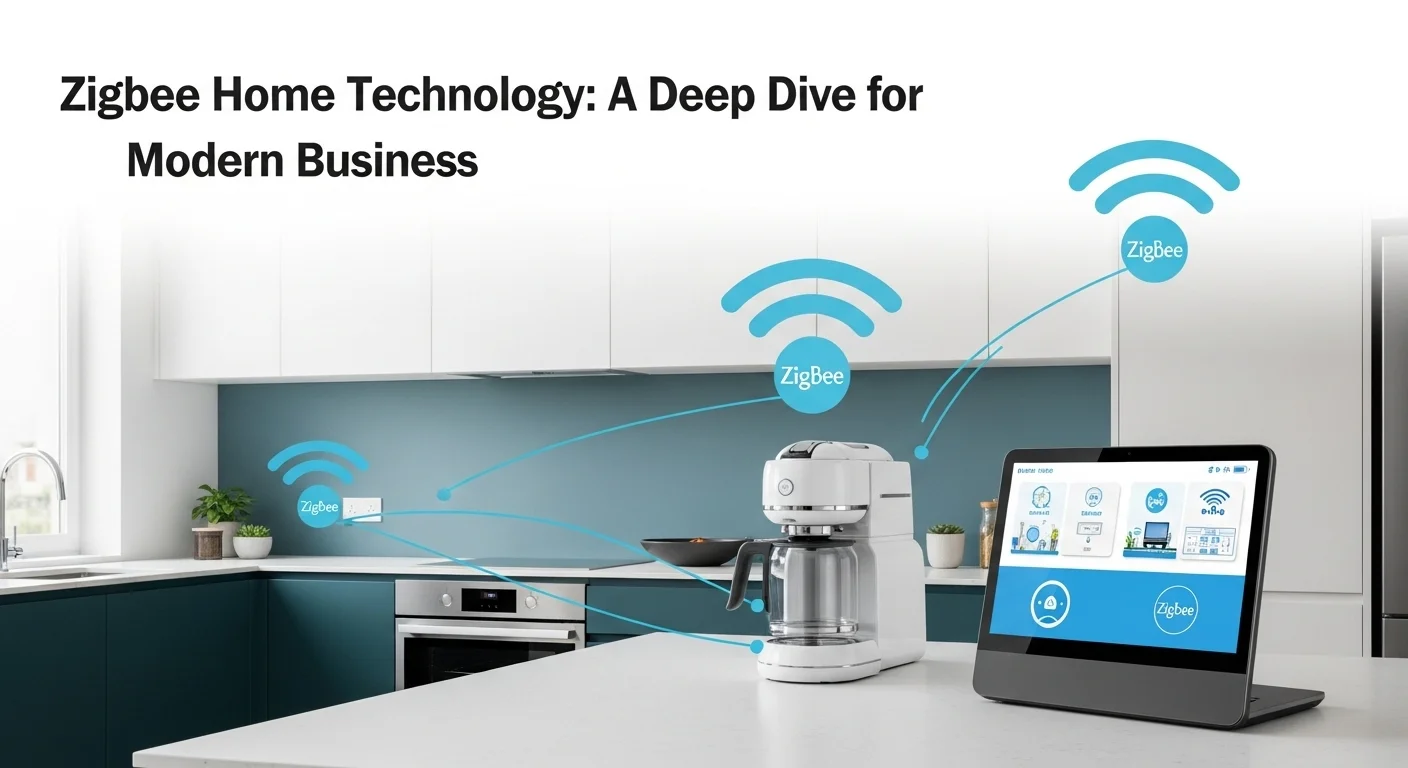What is Zigbee? A Simple Guide to a Smarter Home and Business

Executive Summary
In the world of smart devices, we hear a lot about Wi-Fi and Bluetooth. But there's another key player I've worked with for years that quietly runs millions of smart homes and businesses: Zigbee. Think of it as the unsung hero of the Internet of Things (IoT). It’s a special wireless language designed for devices that don't need a lot of power. This article is your straightforward guide to understanding Zigbee. We'll break down what makes it so efficient—like its clever 'mesh' network where devices help each other pass along signals. This creates incredibly reliable and wide-reaching systems without draining batteries in a day. We'll look at the essential parts of a Zigbee system, why it's often more cost-effective and energy-smart than its rivals, and how it's being used everywhere from making our homes more convenient to making large commercial buildings more efficient. By the end, you'll see why getting to know Zigbee is a smart move for anyone interested in the future of automation.
Table of Contents
What is Zigbee and Why Does it Matter?
In the huge universe of smart technology, you have a lot of wireless options, but Zigbee has really found its sweet spot, especially for home and building automation. So, what is it? At its heart, Zigbee is a wireless standard built for low-power devices that only need to send small bits of information. Unlike your Wi-Fi, which is designed to handle heavy data like streaming movies, Zigbee is optimized for things like a sensor telling a light to turn on. This makes it incredibly energy-efficient. It's why so many zigbee home automation devices, like sensors and smart buttons, can run for years on a single coin battery. I can't tell you how many projects I've consulted on where this feature alone was the deciding factor. The real magic, and why it's so important, is its ability to create a self-healing mesh network. In a Zigbee system, not every device has to be in range of the main hub. Instead, powered devices like smart plugs or light bulbs act as little helpers, or 'routers', passing messages along from devices that are farther away. This web of connections, or mesh, means there's no single point of failure and the network's range can easily cover a large home or office. This built-in reliability is what sets it apart for critical systems like security and environmental monitoring.
The Tech Behind Zigbee
To really get why Zigbee works so well, you have to look under the hood a bit. The technology operates on the 2.4 GHz radio band, the same frequency used by Wi-Fi and Bluetooth. While you might think that's a problem, Zigbee is smart about it, using techniques to avoid getting drowned out by 'louder' signals. Every Zigbee network has a brain, which we call the zigbee home automation controller, or coordinator. This device starts the network, lets other devices join, and acts as the bridge to your Wi-Fi network and the internet, so you can control everything from your phone. The network itself has three types of players: The Coordinator (only one per network), Routers, and End Devices. Routers are your powered devices that form the strong backbone of the mesh. End Devices are the battery-powered gadgets like motion sensors or door contacts. They spend most of their time 'asleep' to save power, waking up only for a split second to send an update. This whole structure is what makes a zigbee home automation system so efficient and robust. The ability to build large, stable networks with hundreds of devices is a huge plus. Furthermore, the organization behind Zigbee, now part of the Connectivity Standards Alliance (CSA), created Zigbee 3.0 to make sure devices from different brands can talk to each other. In my experience, this was a game-changer. It means you can buy a certified bulb from one company and a switch from another, and be confident they'll work together in your zigbee home control system without a headache.
Business Uses and Why It's a Smart Move
Beyond making our homes more convenient, Zigbee is a powerhouse for all kinds of businesses. Its low cost, low power needs, and ability to scale up make it perfect for deploying huge networks of sensors. In commercial buildings, a zigbee home automation system can be expanded to manage lighting, heating, and security across entire floors. This translates directly into massive energy savings and lower operating costs. Imagine lights that only turn on when someone is in the room, or an HVAC system that adjusts based on real-time temperature readings from every corner of the building. In the hotel industry, Zigbee helps create a five-star guest experience. A guest's check-in can trigger a 'welcome' scene in their room, setting the lights and temperature just right. It feels luxurious for the guest and simplifies daily tasks for the staff. For industrial companies, Zigbee is used to track equipment, predict when a machine needs maintenance, and monitor workplace conditions. Tiny sensors can be attached to machinery to listen for vibrations that signal a future breakdown, preventing expensive downtime. The reliability of the mesh network is key here, as it can cover large, complex factory floors without dead spots. The strategic value of Zigbee is that it provides the physical layer for collecting massive amounts of data. As businesses rely more and more on data to find efficiencies, having a cheap and easy way to deploy sensors is essential. The ecosystem of zigbee home automation devices is incredibly mature, offering a solution for almost any task you can think of. This availability of ready-to-go hardware makes it faster and cheaper for companies to build and launch their own IoT solutions. As we move toward a more connected world, the core principles of Zigbee—low-power, reliable, and scalable communication—will only become more vital.

Your Complete Guide to Building with Zigbee
Getting started with a Zigbee solution, whether it's for your living room or a large-scale business deployment, is a journey. It starts with choosing the right gear and understanding how to put it all together. Here’s a walkthrough of the technical steps and strategic thinking I use when building out a Zigbee network. It all starts with the heart of the system: the zigbee home automation controller. This hub is what forms and manages your entire network. You have a few options here. There are user-friendly hubs like an Amazon Echo with a built-in Zigbee radio, or dedicated hubs like those from Aeotec or Hubitat. For tech lovers or businesses needing deep customization, my favorite route is a USB Zigbee stick plugged into a small computer like a Raspberry Pi. Paired with open-source software like Home Assistant, it gives you incredible power and local control. Once you have your controller, it's time to add your zigbee home automation devices. I always tell people to think of them in two groups: routers and end devices. Routers are your powered devices—smart bulbs, plugs, and switches. These are the pillars of your mesh network, and they are crucial for a strong system. I always place these first to build a solid communication backbone. End Devices are the battery-powered sensors that do the cool stuff in your smart home system zigbee—detecting motion, temperature, or if a door is open. The beauty of these is that you can stick them just about anywhere, since you don't need to worry about wires.
How to Set Up and Manage Your Network
Connecting a new device to your network is called 'pairing.' You put the device in pairing mode, tell your zigbee home automation controller to look for it, and they perform a secure digital handshake to connect. It's a straightforward process, and to keep things secure, all Zigbee communication is protected with strong AES-128 encryption. One of the most powerful tools for managing a zigbee home automation system is the network map. Advanced controllers let you visualize your mesh network, showing which devices are talking to each other and how strong the connection is. This is a lifesaver for troubleshooting. If a sensor keeps disconnecting, a quick look at the map might show it has a weak signal, and the solution is as simple as adding a smart plug (a router) halfway between it and the next device. Another technical tip I always give is to be mindful of your Zigbee channel. Zigbee shares the 2.4 GHz band with Wi-Fi. To avoid them tripping over each other, it’s best to set your Zigbee network to a channel that doesn't overlap with your Wi-Fi. Channels 15, 20, or 25 are usually safe bets if your Wi-Fi is on the standard channels 1, 6, or 11. For businesses, scaling a network takes planning. While Zigbee can technically handle thousands of devices, a single network can get congested. For a huge space like an office tower, the best practice is to set up multiple, smaller Zigbee networks (maybe one per floor) and link them together with software. This keeps everything running smoothly and makes the entire system more resilient.
Zigbee vs. The Competition: Making the Right Choice for Business
When you're planning a project, you need to know if Zigbee is the right tool for the job. Let’s compare it to the other main players: Wi-Fi: I call Wi-Fi the data firehose. It's great for high-bandwidth devices like cameras but uses way too much power for small, battery-operated sensors. Z-Wave: This is Zigbee's closest competitor. It's also a low-power mesh network, but it uses a different radio frequency that's less crowded. It's a proprietary standard, which means stricter certification and sometimes higher costs, but device compatibility is usually excellent. Bluetooth Low Energy (BLE): Perfect for one-to-one connections over a short distance, like your fitness tracker syncing to your phone. It can do mesh, but the technology isn't as mature as Zigbee's. For business solutions, Zigbee's strengths are clear. In Smart Buildings, it allows for fine-tuned zigbee home control over lights and HVAC, with systems that can analyze data and optimize energy use. In Healthcare, I've seen it used for non-intrusive patient monitoring, where wireless sensors can track vitals or detect falls, improving safety and freeing up staff. In Retail, it powers smart shelves that report inventory in real-time. Now, you might be hearing about Matter, the new standard backed by all the tech giants. Here's the good news: Matter doesn't replace Zigbee. Many Zigbee hubs are being updated to act as bridges to Matter. This means the huge number of zigbee home automation devices out there won't become obsolete. In fact, investing in a Zigbee system today is a future-proof choice, because it will be able to connect and work with the next generation of smart devices.

Pro Tips for a Flawless Zigbee Experience
Getting the most out of your Zigbee network is about more than just buying devices; it's about being strategic. A little bit of planning can turn a basic setup into a rock-solid, responsive automation powerhouse. Whether you’re a homeowner tweaking your setup or a business deploying a critical system, these are the strategies I've learned over the years to unlock Zigbee's full potential. The absolute most important thing for a successful zigbee home automation system is building a strong mesh. The whole point of Zigbee is that devices can talk through each other, so where you put them is critical. Start with your zigbee home automation controller. Place it somewhere central in your building, not tucked away in a basement or a cabinet full of other electronics that can cause interference. Next, build your network's backbone using your router devices. A huge mistake I see people make is trying to connect all their little battery sensors first. Don't do that. Instead, pair your mains-powered zigbee home automation devices—the smart plugs, bulbs, and switches—starting with the ones closest to the controller and working your way out. As a rule of thumb, try to have a router device every 15-30 feet. This creates overlapping coverage and multiple paths for signals to travel, which is what makes a smart home system zigbee so reliable. If one device goes offline, the network automatically finds another way. That self-healing capability is pure genius.
Best Practices for a Secure and Healthy Network
Zigbee has strong built-in encryption, but overall security is a team effort. The first step to securing your zigbee home control is protecting the controller itself. Since it's connected to your home network, make sure it has a strong, unique password. If you’re using a DIY setup like Home Assistant, always keep the software up to date to get the latest security patches. Regular maintenance is also key. I recommend checking your controller's dashboard once a month for devices with low batteries and replacing them before they die unexpectedly. Keep an eye on network health, especially the Link Quality Indicator (LQI). If a device consistently has a poor signal, it might be too far from a router, or there might be something causing radio interference. Speaking of interference, the 2.4 GHz band can be a crowded party. Wi-Fi, Bluetooth, and even your microwave can be noisy neighbors. Your Zigbee controller is smart enough to pick a quiet channel when you first set it up. But if you later install a new Wi-Fi system that stomps on that channel, you might see problems. The best practice is to set your Wi-Fi router to use channels 1, 6, or 11, and then you can manually set your Zigbee network to a channel in between, like 15, 20, or 25, to give everyone their own space.
Unlocking Superpowers with AI, Cloud, and Advanced Tools
The real magic begins when you connect your zigbee home automation system to other technologies like AI and the cloud. By linking your local Zigbee hub to services like Amazon Alexa, Google Assistant, or Apple HomeKit, you get voice control and can create incredibly powerful routines. A simple 'good night' command can trigger a sequence: all Zigbee lights turn off, the Zigbee front door lock engages, and the thermostat adjusts for the night. For businesses, cloud integration opens up a world of possibilities. Data from thousands of Zigbee sensors can be sent to a cloud platform for analysis. A building manager can see energy usage patterns and pinpoint waste. A farmer can use data from soil sensors to automate irrigation with incredible precision. AI takes this even further. With machine learning, a system can learn from historical data to make predictions. For example, an AI could learn the normal vibration patterns of a factory machine and alert staff before it breaks down, based on subtle changes detected by Zigbee sensors. In a home, an AI could learn your family’s habits and start adjusting lights and temperature proactively. It’s about creating an environment that anticipates your needs. If you want to dive deeper, I highly recommend keeping an eye on industry blogs like Stacey on IoT for expert analysis on what's next. In the end, a great Zigbee experience comes down to smart planning, good security habits, and creative integration. By building a strong mesh foundation and leveraging the power of AI and the cloud, you can create a truly intelligent zigbee home control system that makes life and business better.
Expert Reviews & Testimonials
Sarah Johnson, Business Owner ⭐⭐⭐⭐
This was a very clear explanation. The section on business applications and how Zigbee can reduce operational costs was exactly what I needed to see. More examples like that would be great!
Mike Chen, IT Consultant ⭐⭐⭐⭐⭐
Fantastic article. I've worked with Zigbee before, but the pro tips on channel selection and building the mesh with routers first were genuinely helpful. It confirmed some of my own best practices. Well written!
Emma Davis, Smart Home Enthusiast ⭐⭐⭐⭐⭐
Excellent guide! As someone just starting to build a smart home, the comparison between Zigbee, Z-Wave, and Wi-Fi was perfect. I finally understand why my battery-powered sensors need Zigbee. Thanks!



